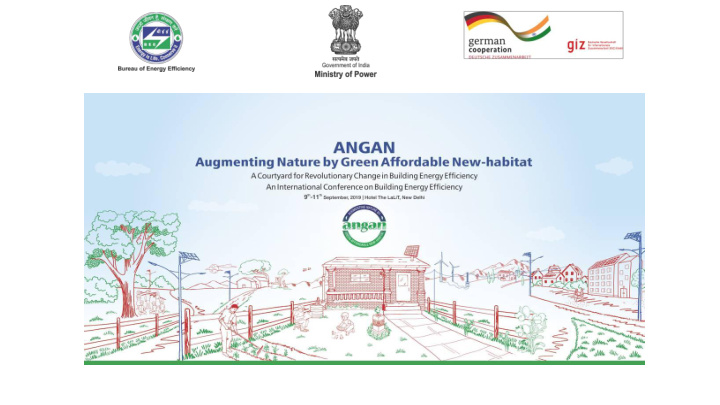



THIS PRESENTATION WAS SHARED BY Dr. Anir Upadhyay Architect and Urban Planner, Faculty of the Built Environment, UNSW, Sydney FOR THE SESSION: “Climate Resilience in Buildings” DURING ANGAN 2019
Climate Resilient Architecture: Design for the future climate -Dr Anir Upadhyay B. Arch, MSc (Urban Planning), PhD (Sustainable Design) Lecturer, UNSW Built Environment
What is resilience? “Resiliency is a multifaceted lens which balances proactivity and reactivity to inform solutions to disruptions .” (The Resilient Design Institute, 2019)
What is resilience? “Resiliency is a multifaceted lens which balances proactivity and reactivity to inform solutions to disruptions .” (The Resilient Design Institute, 2019)
Climate disruptions
Reversing climate disruptions Focus on new commitments Shift away from fossil fuels and towards renewable energy on low-emission buildings https://www.un.org/en/climatechange/un-climate-summit-2019.shtml
Reversing climate disruptions Focus on new commitments Shift away from fossil fuels and towards renewable energy on low-emission buildings Net zero carbon/super low energy/near zero energy buildings https://www.un.org/en/climatechange/un-climate-summit-2019.shtml
Zero energy buildings An energy-efficient building where, on a source energy basis, the actual annual delivered energy is less than or equal to the on-site renewable exported energy. https://www.energy.gov/sites/prod/files/2015/09/f26/bto_common_definition_zero_energy_buildings_093015.pdf
Zero energy buildings https://www.energy.gov/sites/prod/files/2015/09/f26/bto_common_definition_zero_energy_buildings_093015.pdf
Designing for the climate (Lechner, 2014 p.9)
Designing for the climate Heat protection/ rejection (www.designingforclimate.com.au, 2018)
Designing for the climate Heat gain/ retention (www.designingforclimate.com.au, 2018)
Cooling strategies Hot and Dry climate Hot and Humid climate Gaza, Israel, Middle East Malay house, Malaysia (http://eartharchitecture.org/?tag=domes) (http://nalenda14.blogspot.com.au/2010/11/malay- vernacular-architecture.html)
Indian climate zones http://www.econiwas.com/tool/ (Bansal and Minke,1988)
Indian climate zones (www.mnre.gov.in/solar-energy/ch2.pdf)
Indian climate zones (Bansal and Minke, 1988)
Indian climate zones Published in 1993
Thermal environmental conditions (Upadhyay, 2018)
Thermal environmental conditions Month Year Jan 1995 Feb 1994 Mar 1998 Apr 1990 May 1996 Jun 1998 Jul 1996 Aug 1997 Sep 1991 Oct 2001 Nov 2003 Dec 1993
Ahmedabad climate outlook Ahmedabad Classified as hot-dry
Ahmedabad climate outlook Ahmedabad Classified as hot-dry
Ahmedabad climate outlook Ahmedabad Classified as hot-dry
Torrent Research Centre, Ahmedabad https://archnet.org/sites/4454/media_contents/17672 https://archnet.org/sites/4454/media_contents/17675
Sangath, Ahmedabad
Ahmedabad climate outlook (2050) Ahmedabad should be Classified as hot-dry hot-humid/ humid
Chennai climate outlook Chennai Classified as warm-humid
Chennai climate outlook (2050) Chennai should be Classified as warm-humid hot-humid
Bangalore climate outlook Bangalore Classified as temperate
Bangalore climate outlook (2050) Bangalore should be Classified as tempearte warm-humid
Srinagar climate outlook Srinagar Classified as cold
Srinagar climate outlook (2050) Srinagar Classified as cold
New Delhi climate outlook New Delhi Classified as composite
New Delhi climate outlook (2050) New Delhi should be Classified as composite predominantly hot- humid + a brief cool period
Resilient Design Strategies • Design and construct (or renovate) buildings to handle severe climate related impacts that are expected to result from a warming climate . • Model design solutions based on future climatic conditions as much as possible, rather than relying on past data. • Rely on vernacular design practices that were prevalent before the advent of air conditioning and central heating. Combine these design strategies with modern materials to optimize resilient design. (The Resilient Design Institute, 2019)
Let’s collaborate (https://gharpedia.com/wp-content/uploads/2019/02/Bhunga-Kutch-06-0101040001-1024x354.jpg)
Thanks! Dr Anir Upadhyay E: anir.upadhyay@unsw.edu.au
Recommend
More recommend